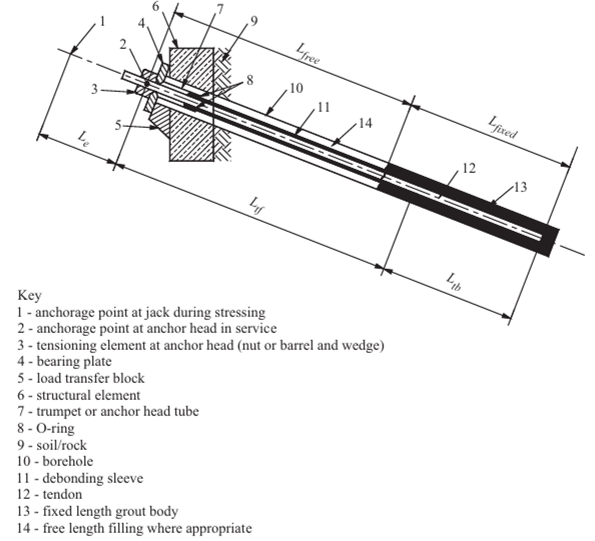
Source: Sketch of a bond type ground anchor (EN 1537:2013; ISO 22477-5:2018)
Cable Anchor are advanced reinforcement device used in integration of passive systems to counteract higher loads. The Anchors transfer tensile load to the ground to take of stresses generated due to loss of effective stress.
In Geo-technical engineering it is termed as “Prestressed Post tensioned Grouted Ground Anchors”. The ground anchors can be made by using Wire or cable Anchors of high grade steel Bars.
The total length of Bar/ Wire strand is differentiated into free length and fixed length. Forces are transmitted to the ground via the bond length/fixed length. Anchor depths could be varied for getting end anchorage and desired frictional coefficient to withstand the pull-out stress. High rated capacity drilling rigs are used for precise, stabilized drilling in dry as well wet condition.
Anchors are classified on the basis of grouting technique, its injection method is vital, as it determines the strength of the anchorage in the ground and its performance. It is determined by the geo-technical engineering investigation at our office and comprise attributes like.
Grout pressures
Primary and secondary grout induce time
Ground condition/ Rock type and its condition
The gravity is employed in the fixed length zone & divisible into 4 categories.
Straight Shafted Gravity Grout flow
Pressure Grout
Post Grouted
Under reamed grouting
Applications:
- Slope stabilization (Global Stabilization)
- Retaining system rehabilitation
- Uplift Resistant
- Deep Excavations
- Tie down system
- Stitching of parallel tunnels
- Strengthen and retention of the galleries of tunnels by balancing the forces of the adjoining area
- Vertical Prestressed Cable anchors improve dam’s rollover resistance
Advantage:
- Control instability of slopes
- Suitable for all geological environments
- Deformations are minimized
- Higher Load capacities
- Can be designed for temporary system and be retrieved after work completion
- Suitable for all kind of facing systems
- Control risk of seismic load